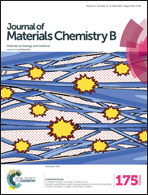Improved in vivo tumor therapy via host–guest complexation†
Abstract
In order to improve the effectiveness of cancer therapy and reduce the adverse effects of conventional chemotherapy, the development of less toxic, biocompatible, decomposable and pH-responsive nano-containers is of great importance. In this work a novel nano-container is designed and synthesized by doping a water-soluble pillar[5]arene WP5 onto hollow mesoporous silica nanoparticles (HMNPs) via host–guest complexation. This nano-container decomposes into small water-soluble fragments to achieve a highly efficient release of the loaded anticancer drug doxorubicin. Importantly, the complexation of WP5 molecules with HMNPs significantly improves the inhibition of tumor growth in vivo with minimal side effects, which can be attributed to the pH-responsiveness of the host–guest interactions. Under the extracelluar conditions, the host–guest complexation between WP5 and HMNPs enhances the loading of doxorubicin molecules. However, this host–guest complexation is prohibited under the low pH conditions in intracellular lysosomes, so that doxorubicin is released readily from the vector. The present novel drug delivery system demonstrates the great potential of host–guest complexation for cancer therapy improvement.


 Please wait while we load your content...
Please wait while we load your content...